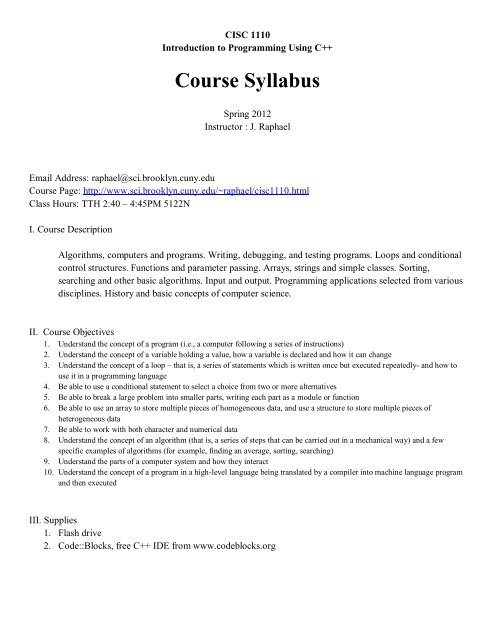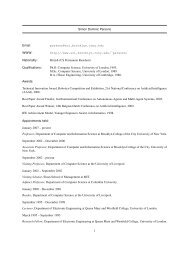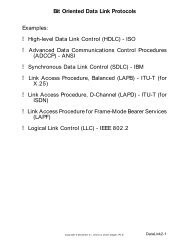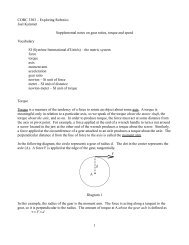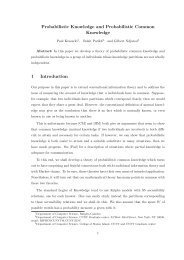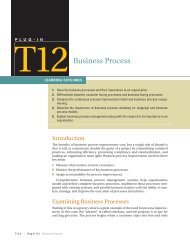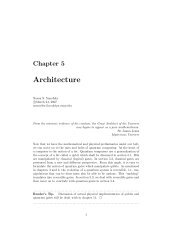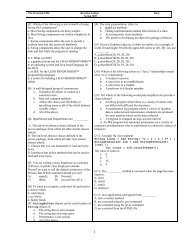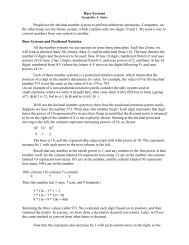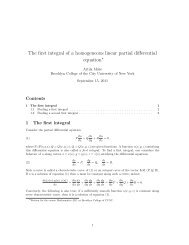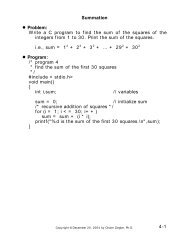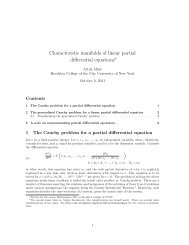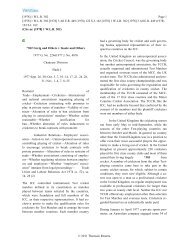Course Syllabus - Computer and Information Science - CUNY
Course Syllabus - Computer and Information Science - CUNY
Course Syllabus - Computer and Information Science - CUNY
Create successful ePaper yourself
Turn your PDF publications into a flip-book with our unique Google optimized e-Paper software.
CISC 1110<br />
Introduction to Programming Using C++<br />
<strong>Course</strong> <strong>Syllabus</strong><br />
Spring 2012<br />
Instructor : J. Raphael<br />
Email Address: raphael@sci.brooklyn.cuny.edu<br />
<strong>Course</strong> Page: http://www.sci.brooklyn.cuny.edu/~raphael/cisc1110.html<br />
Class Hours: TTH 2:40 – 4:45PM 5122N<br />
I. <strong>Course</strong> Description<br />
Algorithms, computers <strong>and</strong> programs. Writing, debugging, <strong>and</strong> testing programs. Loops <strong>and</strong> conditional<br />
control structures. Functions <strong>and</strong> parameter passing. Arrays, strings <strong>and</strong> simple classes. Sorting,<br />
searching <strong>and</strong> other basic algorithms. Input <strong>and</strong> output. Programming applications selected from various<br />
disciplines. History <strong>and</strong> basic concepts of computer science.<br />
II. <strong>Course</strong> Objectives<br />
1. Underst<strong>and</strong> the concept of a program (i.e., a computer following a series of instructions)<br />
2. Underst<strong>and</strong> the concept of a variable holding a value, how a variable is declared <strong>and</strong> how it can change<br />
3. Underst<strong>and</strong> the concept of a loop – that is, a series of statements which is written once but executed repeatedly- <strong>and</strong> how to<br />
use it in a programming language<br />
4. Be able to use a conditional statement to select a choice from two or more alternatives<br />
5. Be able to break a large problem into smaller parts, writing each part as a module or function<br />
6. Be able to use an array to store multiple pieces of homogeneous data, <strong>and</strong> use a structure to store multiple pieces of<br />
heterogeneous data<br />
7. Be able to work with both character <strong>and</strong> numerical data<br />
8. Underst<strong>and</strong> the concept of an algorithm (that is, a series of steps that can be carried out in a mechanical way) <strong>and</strong> a few<br />
specific examples of algorithms (for example, finding an average, sorting, searching)<br />
9. Underst<strong>and</strong> the parts of a computer system <strong>and</strong> how they interact<br />
10. Underst<strong>and</strong> the concept of a program in a high-level language being translated by a compiler into machine language program<br />
<strong>and</strong> then executed<br />
III. Supplies<br />
1. Flash drive<br />
2. Code::Blocks, free C++ IDE from www.codeblocks.org
IV. Grading<br />
8 HW/Programs 25%<br />
2 Projects 25%<br />
2 Exams 20%<br />
Final 30%<br />
V. Final<br />
[TBD]<br />
VI. Academic Integrity<br />
The faculty <strong>and</strong> administration of Brooklyn College support an environment free from cheating <strong>and</strong><br />
plagiarism. Each student is responsible for being aware of what constitutes cheating <strong>and</strong> plagiarism <strong>and</strong> for<br />
avoiding both. The complete text of the <strong>CUNY</strong> Academic Integrity Policy <strong>and</strong> the Brooklyn College procedure<br />
for implementing that policy can be found at this site:<br />
http://www.brooklyn.cuny.edu/bc/policies.<br />
If a faculty member suspects a violation of academic integrity <strong>and</strong>, upon investigation, confirms that<br />
violation, or if the student admits the violation, the faculty member MUST report the violation.


